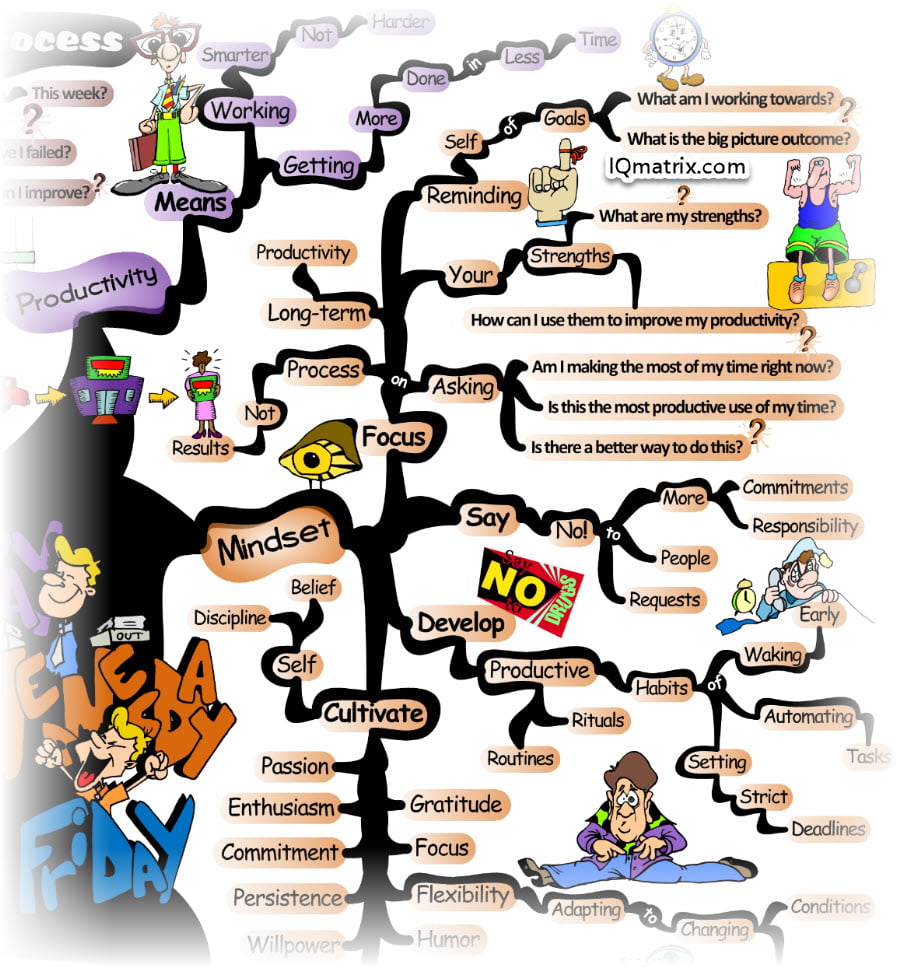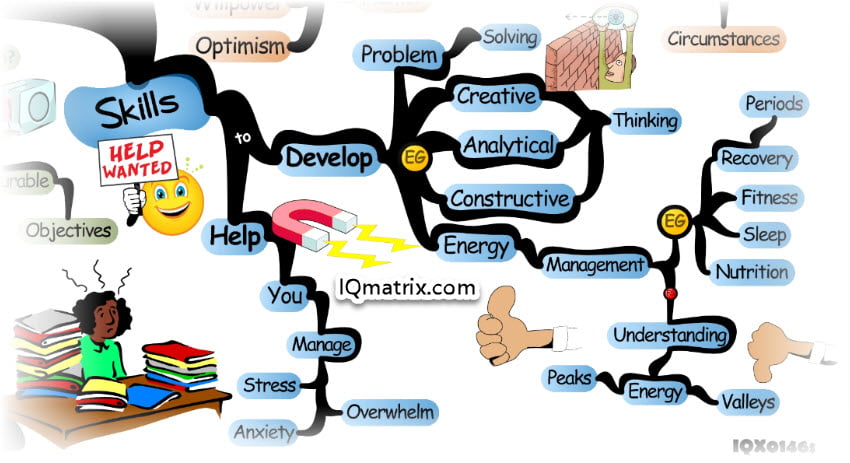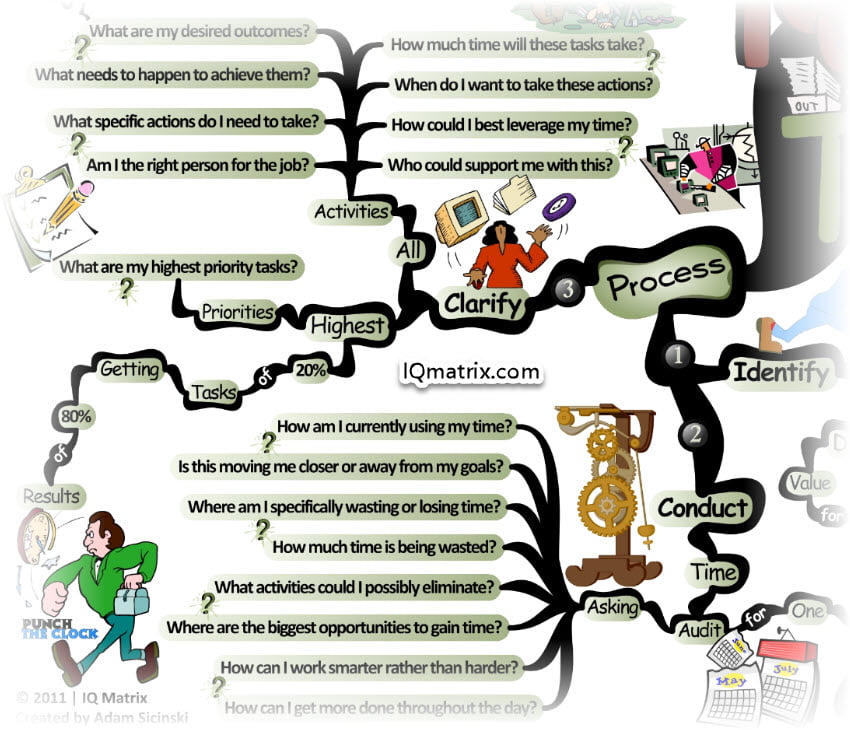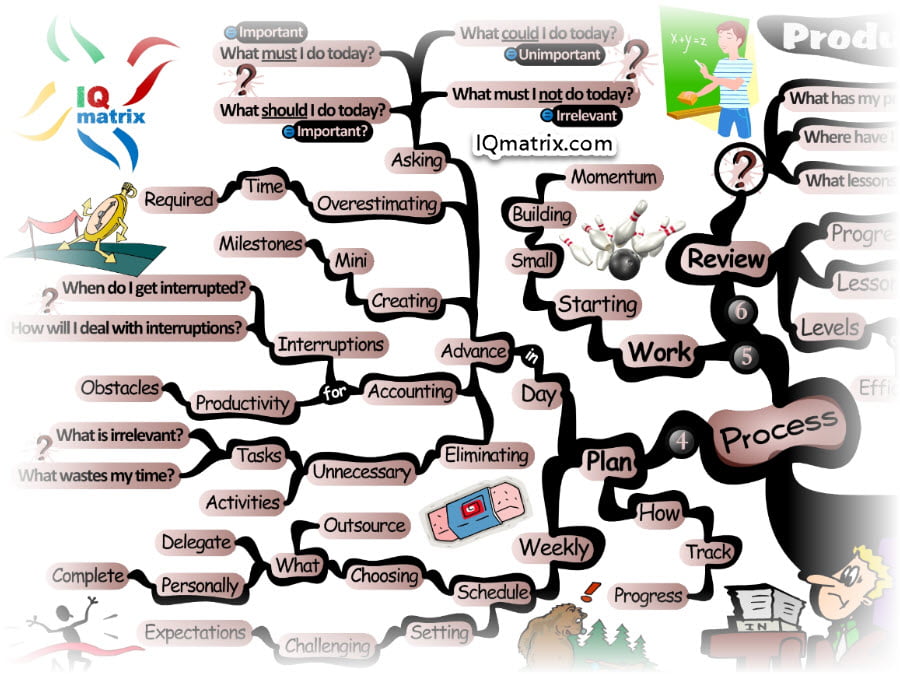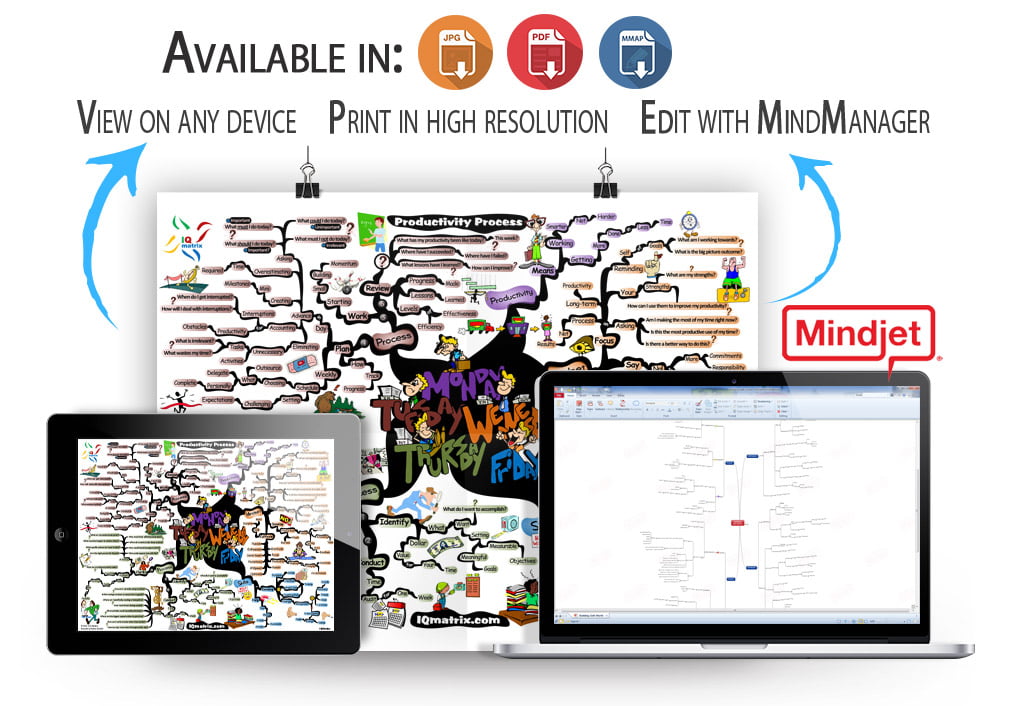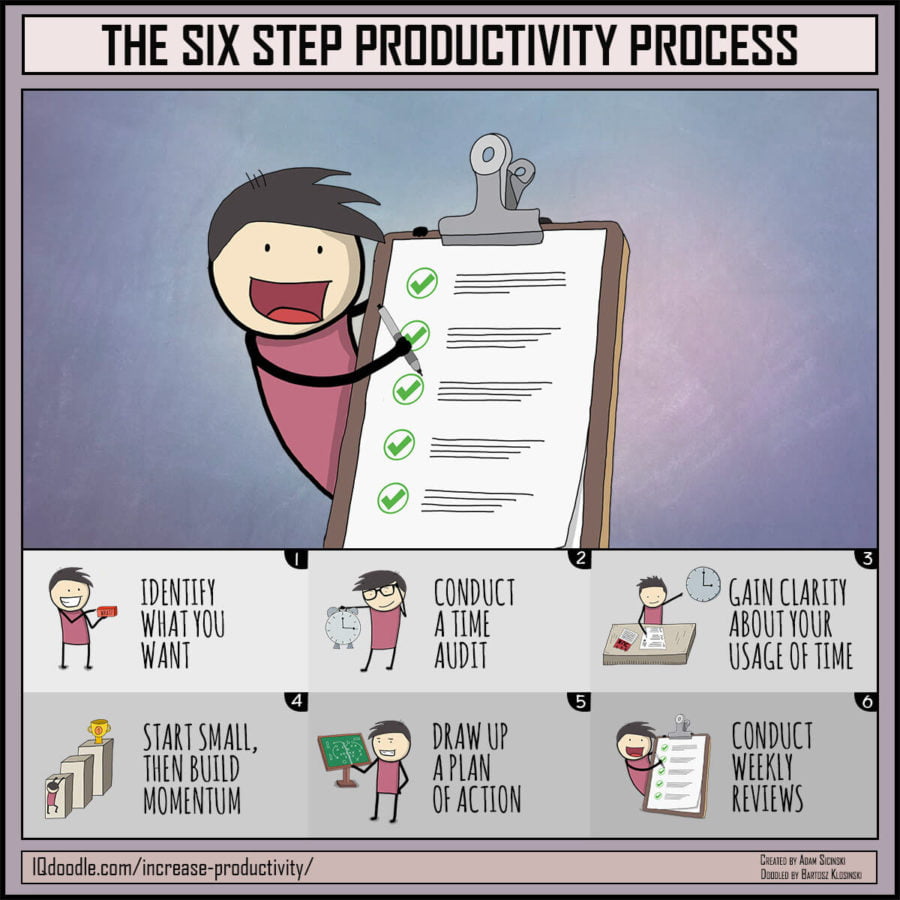Efficiency is doing things right; effectiveness is doing the right things. – Peter Drucker
What does productivity mean to you?
Productivity often means different things to different people. When we think of productivity we often imagine working more effectively and efficiently without distraction. Being productive means being an effective time manager; having the ability to organize yourself and your environment; it means understanding how to outsource and delegate, and of course, it involves focusing on your highest priority activities that will bring you the highest long-term value.
Bringing all these ideas about productivity together, we may come up with a definition that goes a little something like this: Productivity means getting more done in less time by working smarter not harder.
This is all well and good, but how do we go about getting more done in less time by Working Smarter, Not Harder? Well, it’s a process. It’s something that we need to work on progressively over time. It’s like any skill that requires commitment, focus, patience and a willingness/openness to learn, experiment and grow from the experience. You will not just suddenly wake up tomorrow and be productive. Essential habits, the right mindset, and some valuable skills need to be developed. As such this is not something you can do overnight, it’s rather something that takes patience and time.
The Mindset of Productive Individuals
The six-step productivity process outlined a little later in this article will not work for you unless you are mentally prepared and willing to go about your day in a very specific way.
Productivity requires a very specific attitude and frame-of-mind that will allow you to make the best use of your time moving forward. Without the necessary focus, without the ability to say “no”, and without the right attitude you will struggle to work productively throughout the day.
It’s important to understand that the goal here is long-term productivity. Anyone can be productive in the short-term. However, it requires a certain kind of mindset to maintain high levels of productivity for the long-term. However, long-term productivity doesn’t mean that you are focused on some end goal or result. It actually means the opposite. Long-term productivity means focusing on the “process” and not on the results. Focusing on the process of working through a task will help you to stay focused for longer periods at a time. On the other hand, focusing on results will just distract you from the process especially if desired outcomes are hard to come by.
Let’s quickly break down what the mindset of a productive individual looks like.
They Know What They Want
Productive people always know what they want. They know what they want long-term and they, therefore, understand what they must do short-term in order to bring those goals to fruition.
Throughout the day they do of course focus on the present moment and what must be done “right now” to get them further along their path. However, they do take time to remind themselves of the most important things they are working towards. They do this by asking two simple questions before undertaking a task:
What am I working towards?
What is the big picture outcome I desire to achieve as a result of accomplishing this task?
With these questions in mind, they are able to work on the task at hand with more focus, motivation and a sense of purpose. Every task they do matters because it’s aligned with the bigger picture of what they are working towards in the long-term.
They Understand Their Strengths
Productive people understand their strengths. They understand what they are good at and where they struggle most. They then focus on working to their strengths and often look for external help in other areas.
Throughout the day, they will often remind themselves of their strengths by asking the following questions:
What are my strengths?
Is this task complimentary of my strengths?
If yes, then how can I use my strengths in this situation to improve my productivity?
If no, then who might be able to assist me with this task to ensure that I stay highly productive?
They Stay Focused on the Present Moment
Even though productive people are aware of their long-term goals and objectives, they do however stay very vigilant of the present moment to ensure that they are working on the task in the most optimal way. To do this they often ask several critical questions:
Is this the most productive use of my time right now?
Am I working on this task in the most optimal way?
Is there a better way I could potentially do this?
While working on a task they don’t just accept that there is one way to do something. They are always looking for better, faster and smarter ways to get the job done. And consistently asking these questions throughout the day helps them to stay vigilant and focused on making gradual improvements to their work routine.
They Are Not Afraid to Say “No”
Productive people understand the value of their time. They understand how precious each and every minute is. Too many distractions throughout the day can completely derail their efforts. Which is why they understand the value of saying “no” to unnecessary and low-value distractions, to requests, to more commitments, or more responsibility that just don’t add any long-term value.
Many people succumb to distractions because they have no definitive aim. They have no big picture outcome that they are working towards. However, productive people keep their main goals and objectives at the forefront of their mind. Anything that potentially pulls them off this path they will sidestep. They won’t fall into the trap of being sidetracked from the task at hand because they are willing and able to say “no” to unnecessary and often unimportant distractions. The value of their time is far too precious to spend on helping other people put out fires. There is, of course, a time and place for this, but for the most part, productive people set very clear boundaries that help them maintain high levels of productivity throughout the day.
They Indulge in Productivity Enhancing Habits
Productive people have very specific habits and rituals that they tend to indulge in. These habits will, of course, vary from person to person. There is no one set of habits that will fit every person or every work routine. However, on the most part productive people tend to develop empowering productive habits in three main areas:
- Sleep Schedule: They wake up early with the purpose of working for several hours without distraction, or to partake in a morning routine that helps keep them stay centered and focused throughout the day. Or they might stay up late for the same reasons.
- Task Automation: They automate their tasks and activities wherever possible. When things are automated they no longer need to think about what needs to get done. Things just get done with the least amount of time and effort.
- Strict Deadlines: They set very strict deadlines. Deadlines help them to stay focused. In fact, deadlines allow them to work with a sense of urgency that encourages them to work smarter throughout the day.
There are of course many other habits that can help enhance your levels of productivity. In fact, the entire six-step process for productivity outlined below is built upon many small habits that come together to help you make better and smarter decisions throughout the day.
They Understand the Importance of a Cultivating the Right Attitude
Productive people recognize that in order to maintain high levels of productivity that they must cultivate the right attitude. This is important because the right attitude will help them to stay energized, focused and inspired throughout the day. But what is the right attitude? What does productivity actually require from you?
The right attitude that can help you maintain high levels of productivity throughout the day can be seen as a combination of self-discipline, self-belief, passion, enthusiasm, gratitude, commitment, focus, persistence, willpower, humor, optimism and a willingness to maintain a flexible approach to changing conditions and circumstances. All of these variables make up your attitude. And with this attitude in place, you will be in a prime position to make the best use of your time moving forward.
Developing Critical Productivity Skills
In order to boost your levels of productivity throughout the day, it’s helpful to work on developing several complimentary soft skills that will enhance how you work and how you think about your tasks, projects, and activities. In fact, your ability to maintain high levels of productivity will coincide with your proficiency in these areas.
Let’s now quickly look at three critical soft skills that will help you improve your levels of productivity.
Managing Difficult Emotions
Throughout the day we will often experience a plethora of emotions. A tight deadline, for instance, might trigger stress. Too many responsibilities at a time might cause overwhelm. Or a mistake or oversight on our part might create anxiety. These are examples of just three difficult emotions you might need to deal with as you work through your day. However, you might also experience frustration when things are not working out as expected, or even anger when others dump their work on your desk. Or you might even experience nervousness when preparing for that big presentation. These are all no doubt very difficult emotions to deal with. But deal with them you must, or otherwise, your productivity will suffer.
You must essentially work on responding proactively to events and circumstances instead of reacting to them emotionally. Emotional reactions will only create distractions and your productivity will suffer as a result.
All this, of course, comes down to developing a level of emotional intelligence where you are able to successfully channel your emotions in a helpful way that works for you rather than against you. Please read the Mastering Your Emotions article for a detailed explanation of this process.
Problem Solving Skills
As you go about your day you will face a variety of obstacles and challenges. Your ability to work through these problems successfully will effectively determine your level of productivity.
Whether we are talking about problem-solving, creative thinking, or critical thinking, all of these approaches will enhance how you work throughout the day. The more familiar you are with these thinking skills, the more effectively you will think through daily challenges you might potentially face. Moreover, these thinking skills will help you find better and faster ways to get things done.
Commit yourself to taking time to learn more about each of these thinking skills, and begin applying them as you work through your daily tasks and activities.
Energy Management
No matter how well you are able to manage your emotions, and no matter how good your thinking skills are, you will always struggle to stay productive if you are lacking in energy. This is were some knowledge and understanding about how to manage your energy levels is of most value.
When we have an abundance of energy, we are able to think far more effectively, we are able to work far more quickly, and we just feel better about ourselves and about the tasks and activities we are working on.
Effective energy management involves a daily exercise regiment, adequate sleep, proper nutrition, as well as regular periods of rest and recovery. However, even if you have all of these ticked off your list, there is still one other essential component that you will need to first recognize and then manage throughout the day. That is, of course, working with the cycles of energy you experience over a period of 24 hours. You need to be able to work with your natural energy cycles in an optimal way in order to maintain peak levels of productivity.
Energy cycles are the natural peaks and valleys of energy we tend to experience as we go about our day. For instance, you might feel most energetic and alert first thing in the morning. Then during the period after lunch, you might feel a little more lethargic and sluggish. Then in the evening, you might feel more energetic once again.
These energy peaks and valleys will differ from person to person. You must, therefore, recognize your cycle and then adapt your schedule accordingly. For instance, when you’re feeling alert and energized in the morning, this might be a good time to undertake tasks and activities that require more thought and mental energy. Then in the afternoon when you’re feeling more sluggish and lethargic it might be more worthwhile running errands or focusing on tasks and activities that don’t require a lot of mental energy. Then in the evening when you’re feeling more energized, focus again on tasks that require more thought and attention.
Working with your energy cycles in this way will ensure that you maintain high levels of productivity at all times. And of course, working against these cycles will mean that you will often get caught up doing the wrong things at the wrong time and have very little to show for your efforts.
The Six Step Productivity Process
Within this final section let’s go through a six-step productivity process that will help you to better organize your life as well as manage your time. It is, of course, important to point out that productivity is a process. Getting familiar with a process can take some time. This is not something that you will suddenly learn today and master tomorrow. It takes practice, and it takes patience to develop specific habits that will help you to manage your life and organize your time more effectively. So with that said, let’s jump into the first of the six steps.
Step 1: Identify What You Want
Your first step is to specify what it is exactly that you want. These are the goals that you would like to achieve in the long-term, followed by medium and short-term goals that will help you get there. Your goals must, of course, be measurable and meaningful. Measurable means that you clearly understand what it will take for you to achieve your goals and meaningful means that these goals matter. The more reasons you can find to achieve these goals, the higher level of motivation you will have moving forward. For more information on how to set effective goals, please read How to Set Smart Goals. Alternatively, you can use the GROW Model for goal setting purposes as well.
To gain clarity about the goals you would like to achieve, ask yourself:
What would I like to accomplish?
What are my long-term goals and objectives?
What are my medium and short-term goals that will help me get to my long-term aim?
How will I know when these goals have been achieved? How will these goals be measured?
Why is it important for me to accomplish these goals? Why now?
Finally, it’s important you assign a monetary value to your time. We want to do this because often we simply don’t respect the hours we have throughout the day. Your goals obviously have value. And therefore the time you spend working on them also has value. As such, take time right now to identify a dollar value for the time you will spend working on your goals. Ask yourself:
What are my goals worth from a monetary perspective?
If someone was to pay me to work on these goals, how much would I charge per goal? How much per hour or day?
The real purpose of establishing a monetary value for your time is so that you work with more urgency and don’t waste your time on unnecessary and irrelevant tasks and activities that don’t get you to your desired outcome. In other words, it’s all about working on the most important things that will get you to your goal as quickly as possible. And if along the way someone tries to distract your focus and attention onto something else, then all you need to do is remind yourself of your value per hour and then figure out where your time is worth spending.
Step 2: Conduct a Time Audit
It’s now important to figure out how you are currently making use of your time. This process is known as a “time audit” and it will help you to get a better idea of where your time is going and where you could make adjustments moving forward.
A typical time audit will often last for a week, although three to four days can often be enough to provide you with the clarity you need. And all that’s required from your end is to simply jot down what exactly you are doing at 15-minute intervals throughout the day. You can find more information about conducting a time audit here and here.
Once you have completed this process, spend some time overviewing how you have utilized your time and ask yourself the following questions:
How am I currently using my time?
Is how I’m using my time moving me closer or further away from my goals?
Where am I specifically wasting or losing most time?
How much time is being wasted each day/week?
What activities could I potentially eliminate?
Where are the biggest opportunities to gain time?
How can I work smarter rather than harder? What specifically must I do?
How can I potentially get more done throughout the day by working in this way?
Answering these questions will help you to gain a deeper understanding of where you could improve your time management skills moving forward. However, simply answering these questions will not suddenly help boost your levels of productivity. We need to gain some more clarity in other areas as well.
Step 3: Gain Clarity About How to Best Utilize Your Time
There is one thing you must always keep in mind when it comes to utilizing your time most effectively. This one thing is to focus on your highest priority activities at all times. But what is actually considered a high priority activity? There are no doubt many explanations that could be given here, however, there is just one explanation that sums it up perfectly. This explanation comes in the form of the Pareto Principle. The Pareto Principle states that for many events roughly 80 percent of the effects come from 20 percent of the causes. In other words, 20 percent of the activities you focus on will get you 80 percent of your desired outcomes, while 80 percent of your activities will only get you 20 percent of your desired outcomes/results.
Given all this, we must, therefore, focus on the 20 percent of tasks and activities (your highest priorities) first and foremost before focusing on anything else. However, to identify what tasks/activities fall into this 20 percent you must take some time to gain more clarity about what it is you will need to focus on. Ask yourself:
What are my desired outcomes that I would like to achieve?
What needs to happen for me to achieve these desired outcomes?
What specific actions will I need to take?
How much time will each of these actions take?
What is the short and long-term impact of each of these tasks/activities?
Is the investment of time into each activity worth the resulting outcome I will derive from each activity?
Which of these tasks/activities fall into the 20 percent range of highest priority activities?
Do these activities match the dollar value I placed on my time when I laid out my goals?
Am I the right person to get all these things done? Or would I be better off leveraging my time?
What low value activities that fall into the 80 percent range could I outsource or delegate?
Who could support me to get all these things done efficiently and effectively?
When will I start taking these actions?
Having now gained clarity about your highest value activities, you are now ready to lay down a daily and weekly plan of action.
Step 4: Draw Up a Plan of Action
It’s time now to draw up a plan of action around your highest value activities. Planning is, of course, best done the night before, therefore when you get your day started in the morning you already know exactly what you must focus on. To help you gain some further clarity in this area ask the following questions:
What must I absolutely get done tomorrow? (important)
What should I ideally get done tomorrow? (important?)
What could I potentially get done tomorrow? (unimportant?)
What tasks and activities will I not distract myself with tomorrow? (irrelevant)
It’s important to identify the irrelevant tasks and activities that will only waste your time. List them down and commit yourself to avoiding them at all costs. You might, however, decide instead to outsource or delegate these tasks. If that’s the case then make sure to plan this ahead of time and notify whoever will be involved as early as possible.
Now, having definitively answered these questions, it’s also important to take the following two points into consideration:
- Overestimate the time required to accomplish tasks. Things will almost always take longer than expected. Therefore plan for it in advance.
- For big tasks create mini milestones to avoid overwhelming yourself. Mini milestones also keep your motivation levels high.
It’s also important to account for potential interruptions you might face throughout the day. In other words, account for potential obstacles that may put a damper on your levels of productivity. Ask yourself:
What potential productivity obstacles might I face?
When and where am I most likely to get interrupted?
How will I deal with these obstacles and interruptions?
Planning in advance in this way will streamline your decision-making process throughout the day.
Finally, take time to challenge yourself. Create challenging deadlines and expect the very best from yourself each and every day. When you challenge yourself, you raise your personal standards and expectations and as a result, you are more likely to attain higher levels of productivity. However, be very careful not to overwhelm and burn yourself out too quickly.
Step 5: Start Small, then Build Momentum
Having too much to do and too little time to do it can leave you feeling overwhelmed and burnt out. Starting a productivity regime is a process that you must work on over time. It’s about developing good productive habit that will help you work smarter rather than harder. Taking on too much too early will only hurt your productivity. Instead, start small and build momentum. Install a new productive habit each week and focus on just developing that habit. Then when you’re happy with your progress, instill another habit and build momentum from there.
Step 6: Conduct Weekly Reviews
The final step of the productivity process is to conduct regular weekly reviews. This is critical because when you review you learn more about yourself and about your weekly routine.
Regular reviews help you identify where you have made the most progress and where you have struggled. They also help you learn from your mistakes — encouraging you to make adjustments/improvements to the way you work moving forward.
Set time at the end of each week to review and ask yourself the following questions:
What has my productivity been like over the course of the week?
Where have I accomplished most? Where have I struggled most?
What productive habits have worked for me? Which ones haven’t worked so well?
What lessons have I learned from all this?
How can I use this feedback to help improve my productivity moving forward?
With this productivity process in hand, there are now no good excuses for spending your time on the wrong things. However, the choices you make moving forward are completely up to you. You can either choose to continue doing what you’ve always done; but if you do don’t expect different results. Or you can try doing something new that will help you work far more efficiently and effectively throughout the day. The choice is, of course, yours to make. What will you choose to do?
Time to Assimilate these Concepts
Did you gain value from this article? Is it important that you know and understand this topic? Would you like to optimize how you think about this topic? Would you like a method for applying these ideas to your life?
If you answered yes to any of these questions, then I’m confident you will gain tremendous value from using the accompanying IQ Matrix for coaching or self-coaching purposes. This mind map provides you with a quick visual overview of the article you just read. The branches, interlinking ideas, and images model how the brain thinks and processes information. It’s kind of like implanting a thought into your brain – an upgrade of sorts that optimizes how you think about these concepts and ideas. 🙂
Recommended IQ Matrix Bundles
If you’re intrigued by the idea of using mind maps for self-improvement then I would like to invite you to become an IQ Matrix Member.
If you’re new to mind mapping or just want to check things out, then register for the Free 12 Month Membership Program. There you will gain access to over 90 mind maps, visual tools, and resources valued at over $500.
If, on the other hand, you want access to an ever-growing library of 100s of visual tools and resources, then check out our Premium Membership Packages. These packages provide you with the ultimate visual reference library for all your personal development needs.
Gain More Knowledge…
Here are some additional links and resources that will help you learn more about this topic:
- 5 Powerful Tips for Getting More Stuff Done @ The Week
- 5 Ways to do Nothing and Become More Productive @ 99U
- 9 Habits of Productive People @ Forbes
- 11 Expert Tips to Help You be More Productive @ Fast Company
- 21 Tips to Become the Most Productive Person You Know @ Robin Sharma
- 28 Secrets of Exceptionally Productive People @ Inc.
- How to be a More Productive Person in Your Office @ The Week
- Looking at Productivity as a State of Mind @ New York Times
- On Being More Productive @ Harvard Business Review
- Productivity Tricks for the Neurotic and Crazy @ Huffington Post
- The Simple Science of Getting More Done in Less Time @ Sparring Mind
- Trick Your Lazy Brain into Being More Productive @ CNET
- Why Happiness is Your Secret to Productivity @ Entrepreneur

